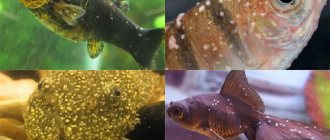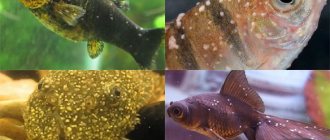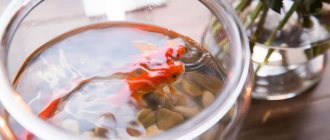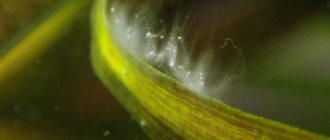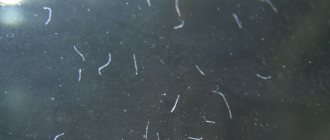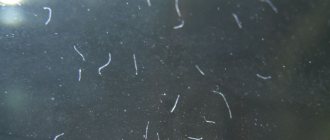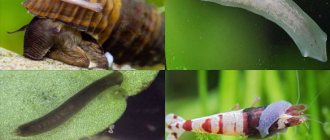White coating on the walls of the aquarium is a fairly common occurrence. As a rule, newbie aquarists encounter it. It occurs due to too high a content of organic substances in the water. A white coating usually develops on the walls in aquariums without living plants when the fish are over-fed or when using highly dusty food. The white coating consists of many small colonies of saprophytic bacteria that have found an abundant food resource for themselves. These colonies may look like shapeless lumps of whitish mucus or even look like thin, whitish, very small worms. However, under a magnifying glass one can see that these are just strands of bacterial mucus passively swaying in the current (if, of course, there is such a current in the aquarium). The white lumpy coating on the walls of the aquarium must be distinguished from the accumulation of hydras on the glass.
What it is?
White deposits in an aquarium are a fairly common phenomenon. This does not pose a great danger (unless it just spoils the appearance of the container) and is the result of incorrect actions and mistakes by the aquarist.
Upon examination, you can see that the plaque consists of white lumps of mucus and individual hairs with mucus strands (outwardly they resemble white worms). This structure indicates that the plaque is of bacterial origin: colonies of bacteria - saprophytes of white or whitish color, feeding on organic substances in the water of the reservoir.
White deposits in the aquarium on plants, driftwood, stones, glass and the ground surface are the result of the active growth of the number of bacteria that have found an abundant food resource.
Prevention, tips and recommendations
Beginners in the business of breeding indoor flora and fauna will benefit from several tips and recommendations for preventing scale:
- Not all filters are capable of preventing calcification; when choosing, you need to pay attention to the features of the reagent, recommendations of sellers and advice from experienced colleagues;
- Most water additives are GH modifiers, which increase the content of minerals and calcium; hardness can be reduced by adding regular distilled water;
- The most effective way to combat lime deposits is regular maintenance; its frequency depends on the volume of the aquarium, the number of its inhabitants, and the capabilities of the equipment, including filters, aeration and lighting systems.
Summarizing what has been said, the most effective methods to prevent the occurrence of plaque are timely care, a balanced ratio of flora and fauna, a adjusted amount of feed, high-quality and efficient equipment.
Reasons for the appearance of plaque in an aquarium
Other factors can also cause the accumulation of water stone: First of all, it is necessary to determine why the white deposit with a lime composition appears. This often occurs due to excessively hard water, which contains high levels of magnesium and calcium salts.
- lack of aquarium flora or its complete absence;
- frequent feeding;
- use of unsettled liquid;
- improper care;
- absence of a filter or its irregular use.
Under no circumstances should you use water that is completely devoid of minerals. This can lead to disruption of the ecological balance of the aquarium, which will ultimately cause the death of the fish.
Possible diseases
If the fish are covered with a white coating, this may indicate an infectious or invasive disease. A mold-like coating should not be confused with a simple clouding of color, which is observed with alkalosis. With alkaline disease in fish, in addition to fading of color, the appearance of mucus on the gills and body, spreading of the fins, restless behavior and cloudy eyes are noted. The cause of the malaise is too high a pH value. After this parameter shifts to the acidic side, the symptoms of alkalosis disappear.
Among the most common infectious diseases are the following:
- dermatomycosis;
- ichthyophthyriosis;
- gyrodactylosis;
- Costiosis;
- Columnaria.
Without treatment for these diseases, fish often die, so correct diagnosis and selection of medications are of great importance.
Dermatomycosis
Dermatomycosis is a fungal disease that affects fish with weakened immune systems. The disease develops after keeping pets for a long time in water with low temperatures, too acidic pH and high levels of organic compounds, as well as with inadequate feeding. A white mossy coating appears on the surface of the fish's body. As the disease progresses, it takes on the appearance of threads and cotton wool, and the body of the fish becomes ulcerated. Sick individuals are treated in the nursery. Make baths with a solution of bicillin-5 at a concentration of 250,000 units per 50 liters of water heated to 26°C. The course of treatment is 4-7 days.
Ichthyophthiriasis
Ichthyophthyriosis is an invasive disease caused by ciliates. An outbreak of the disease occurs after the pathogen is introduced into the aquarium from the outside: with sick fish, water from contaminated reservoirs, undisinfected plants and soil, and live food. Infected fish develop white bumps all over their bodies. White plaque on the fins of aquarium fish in the form of dots is also a sign of ichthyophthyriosis. Sick fish itch against the decorations, tend to the surface of the water, and eat poorly. For treatment, table salt, malachite green, formaldehyde, copper sulfate and potassium permanganate are used. Change the water regularly and increase its temperature.
Gyrodactylosis
Gyrodactylosis is a parasitic disease caused by a monogenetic fluke. Fish infection occurs when sick individuals enter the aquarium. Sick fish become covered with a bluish-white coating, become lethargic, press their fins to their body, move jerkily, and rub against the decorations. As the disease progresses, their eyes become cloudy, ulcers appear on their bodies, and their fins split. Treatment is carried out in a prison. Prepare baths with copper sulfate at a concentration of 15 mg per 10 liters of water. The course of treatment is 7 days.
Costiosis
Costiosis is an invasive disease caused by flagellates. Most often occurs when fish are kept crowded, especially young fish. With costosis, aquarium fish become covered with a white coating, become lethargic, begin to rub against the decorations, and lose their appetite. Gradually, mucus appears on the body, grayish spots appear, the gills are affected, as a result of which the fish breathe heavily and stay at the surface of the water. Treatment is carried out using table salt, malachite green or methylene blue. You can make baths with potassium permanganate: 0.1 g per 10 liters of water. The water temperature is increased to 30-34°C.
Columnaria
Columnaria is an infectious disease caused by bacteria. The development of the disease is facilitated by poor aeration, alkaline pH values, high content of nitrogen compounds, and elevated water temperatures. The main symptom of columnaria is the appearance of grayish-white spots on the head, gills and fins that quickly increase in size. The oral cavity may be affected. A fluffy coating in the form of cotton wool or mold appears on infected areas. A white border appears at the edges of the scales, the body becomes covered with mucus, and the fins are destroyed. Fish movements are difficult. For treatment, methylene blue, table salt and antibiotics are used.
Types of plaques and how to get rid of them?
Any formations on the walls of the aquarium are an unpleasant sight. They can have a wide variety of colors and settle on driftwood, equipment, soil, decorations, and even fish. To know how to deal with the problem and what is the best way to remove them from surfaces, you need to understand what exactly caused them.
Experienced people determine this by color:
- Green plaque indicates the active reproduction of highly organized algae. They are constantly present in small quantities in the water, but only with ample light their population rapidly increases. In order to get rid of this problem, you need to replace a quarter of the volume of water and slightly reduce the light at the first green spots that appear on the glass. The optimal indicators are 0.5 W/l when the lamp operates 8 hours a day. If the algae has grown too much, you can turn off the light completely for a while and drape the tank with black paper for 5-7 days. It is important not to forget to turn on the automatic aeration of the aquarium.
- Brown - appears as a result of the activity of brown algae. They are considered simpler organisms. Often formed when fresh water is colonized by fish. As the balance balances out, the plaque disappears. But if the problem arose in an already existing underwater world, then this indicates a clear lack of natural or artificial lighting. It is enough just to change some of the liquid, wash the walls and add light. Excessive feeding of plants when they cannot cope with excess nutrients leads to a similar result. It is enough to clean the soil and water from excess food and reduce the amount of fertilizer. It may take up to a month and a half to fix the problem.
- Black plaque refers to more serious situations and requires specialist intervention. Feeding your pets a lot of food may be the cause, but if your pets are periodically starving, then the problem could be an algae overgrowth called blackbeard. Experts recommend planting several snails in a container of water to clean up excess food. They eat leftover fish food and clean surfaces naturally.
- White deposits in an aquarium are much more difficult to clean at home, unless it is due to lime deposits. They wash off the easiest. Otherwise, such coating of glass and other surfaces indicates extensive contamination of water with bacteria. This occurs due to organic residues on the ground (extra food, dead leaves) or as a result of the introduction of foreign objects found in natural reservoirs into the underwater world. Most often, the problem is solved by simply cleaning the aquarium and replacing some of the liquid with fresh one. But if it is a bacterial infection, then it is better to use antibiotics.
Depending on what kind of fish you keep, you can try another remedy to normalize the water condition. To do this, use simple salt. If some varieties do not make it possible to change the oxidation of the liquid, then it is enough to add 1 g of salt per liter of tank volume. This substance will slow down the abundant growth of algae. But before using this method, consult with experts whether your pets can live in such conditions.
How to clean the walls of an aquarium and what products to use
However, even the most prudent aquarists cannot avoid the need to regularly remove plaque. For this purpose, there are three main methods, which include the use of special or folk remedies and mechanical cleaning.
Special means
This category includes specially developed cleaning compounds. These can be impregnated wipes, sprays or solutions. They allow you to clean without harming flora and fauna. To this list you need to add softeners, which allow you to remove traces of calcium without replanting the inhabitants and draining the water. An example of such means is:
- Tetratec is a set of wipes impregnated with components that dissolve lime and green deposits;
- Aquarium Pharmaceuticals Safe and Easy, spray for cleaning glass and acrylic surfaces from traces of calcification;
- Aquayer, one of the softeners, when placed in the filter neutralizes calcium salts, reduces the level of hardness, is not recommended for long-term use, after 45 minutes it should be removed from the filter.
The first two options require completely emptying the container. After draining and replanting the fish and plants, the walls of the container are treated with the selected product, left for a few minutes, then the chemicals along with any remaining contaminants are washed off with running water.
Important! Despite the advertised safety of special compounds, after treating the internal cavity with them, the remaining substances must be completely washed off. Its accumulation can harm aquarium inhabitants.
Folk remedies
If special chemicals are not available, there is always the option of using cleaners prepared at home from improvised materials. The most popular products for decalcification remain acid-rich lemon and vinegar, to which ammonia is often added:
- instead of fresh lemon, citric acid is often used, it is also effective against calcium deposits; to prepare a solution, 20 grams of the substance are diluted in a glass of water and stirred until completely dissolved;
- vinegar, composition similar to 200 grams of water, tablespoon of product with 9% concentration, for application you can use a spray bottle or a clean cloth;
- ammonia, alcohol is diluted in a ratio of 1:10 and mixed thoroughly, the application procedure is the same;
- Another effective folk option is the use of peroxide, the substance is diluted in a ratio of 30 ml per 100 water.
The application procedure differs little from that described above. Since all compositions are prepared in the form of liquid solutions for application, it is most convenient to use spray bottles.
Important! Some types of household cleaners can be a burn hazard; for example, when working with vinegar-based solutions, it is recommended to protect your hands with gloves.
How to clean glass and decorations?
The white coating in the aquarium will disappear when the biological balance is restored.
The following steps will help speed up this process:
- Clean the aquarium from rotting organic matter (residues of plants and food).
- What to wash with? You can rinse the aquarium filter sponges without any preparations with plain water.
- Wash dirt from the filter with running water at room temperature.
- As an option: install a filter with a large volume of filter material or a filter that makes it possible to use sorbents (for example, activated carbon).
- Replace 15–20% of the water in the tank with settled water at aquarium temperature.
- Eliminate overcrowding of the aquarium.
- As an option: add nurse fish (for example, ancistrus) to the tank.
- Adjust the fish feeding scheme, consider switching to another, higher quality food.

